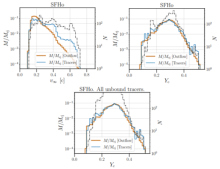
Abstract
Fast material ejected dynamically over <10 ms during the merger of a binary neutron-star (BNS) system can give rise to distinctive electromagnetic counterparts to the system's gravitational-wave emission that can serve as a "smoking gun" to distinguish between a BNS and a NS-black-hole merger. We present novel ab-initio modeling of the associated kilonova precursor and kilonova afterglow based on three-dimensional general-relativistic magneto-hydrodynamic simulations of BNS mergers with tabulated, composition-dependent, finite-temperature equations of state (EOSs), weak interactions, and approximate neutrino transport. We analyze dynamical mass ejection from 1.35-1.35Msun binaries, typical of Galactic double-NS systems and consistent with properties of the first observed BNS merger GW170817, using three nuclear EOSs that span the range of allowed compactness. Nuclear reaction network calculations yield a robust 2nd-to-3rd-peak r-process. We find few x 1e-6Msun of fast (v>0.6c) ejecta that give rise to broad-band synchrotron emission on ~yr timescales, consistent with recent tentative evidence for excess X-ray/radio emission following GW170817. We find 2e-5Msun of free neutrons that power a kilonova precursor on <h timescale. A boost in early UV/optical brightness by a factor of a few due to previously neglected relativistic effects, with appreciable enhancements up to 10h post-merger, provides promising prospects for future detection with UV/optical telescopes such as Swift or ULTRASAT out to 250Mpc. We find that a recently predicted opacity boost due to highly ionized lanthanides at ~70000K is unlikely to affect the early kilonova lightcurve based on the obtained ejecta structures. Azimuthal inhomogeneities in dynamical ejecta composition for soft EOSs found here ("lanthanide/actinide pockets") may have observable consequences for both early kilonova and late-time nebular emission.